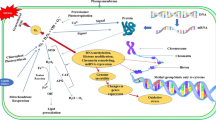Abstract
The introduction of nitrite ions into the bathing medium of broken spinach chloroplasts causes changes in the properties of these organelles which depend on the concentration of nitrite and the time of exposure. In the presence of 1 mM nitrite, there is an inhibition of the rate of oxygen evolution and an increase in fluorescence emission which suggests a site for nitrite inhibition between the two photosystems. When 5 mM nitrite is present for times longer than 10 minutes, there is a decrease in the PS2 partial reaction rate as indicated by the oxygen burst, an increase in the PS1 partial reaction rate, a decrease in fluorescence emission and an increase in the fluorescence emitted at 729 nm compared with that at 693 nm observed at − 176°C. These changes are consistent with an increase in the proportion of absorbed light energy reaching PS1 caused by prolonged exposure to a sufficient concentration of nitrite ions in the light.
Similar content being viewed by others
References
Spiller H and Boger P (1977) Photosynthetic nitrite reduction by dithioerythrotol and the effect of nitrite on electron transport in isolated chloroplasts. Photochem Photobiol 26: 397–402
Stemler A and Murphy JB (1985) Bicarbonate-reversible and irreversible inhibition of photosystem II by monovalent anions. Plant Physiol 77: 974–977
Arnason T and Sinclair J (1976) An investigation of water splitting in the Kok scheme of photosynthetic oxygen evolution. Biochim Biophys Acta 449: 581–586
Vernon LP (1960) Spectrophotometric determination of chlorophylls and pheophytins in plant extracts. Anal Chem 32: 1144–1150
Sinclair J and Arnason T (1974) Studies on a thermal reaction associated with photosynthetic oxygen evolution. Biochim Biophys Acta 368: 393–400
Sinclair J and Cousineau C (1981) The effect of adenosine-5′-triphosphate on oxygen evolution, fluorescence emission and the Emerson enhancement effect. FEBS Lett 136: 213–215
Joliot P, Joliot A and Kok B (1968) Analysis of the interactions between the two photosystems in isolated chloroplasts. Biochim Biophys Acta 153: 635–652
Murata N, Nishimura M and Takamiya A (1966) Fluorescence of chlorophyll in photosynthetic systems. Biochim Biophys Acta 126: 234–243
Waburg O and Luttgens W (1949) Weitere experimente zur kohlensaureassimilation. Naturwissenschaften 32: 301
Allen JF, Bennett J, Steinback KE and Arntzen CJ (1981) Chloroplast protein phosphorylation couples plastoquinone redox state to distribution of excitation energy between photosystems. Nature 291: 25–29
Barber J (1980) An explanation for the relationship between salt-induced thylakoid stacking and the chlorophyll fluorescence changes associated with changes in spillover of energy from photosystem II to photosystem I. FEBS Lett 118: 1–10
Author information
Authors and Affiliations
Rights and permissions
About this article
Cite this article
Sinclair, J. Changes in spinach thylakoid activity due to nitrite ions. Photosynth Res 12, 255–263 (1987). https://doi.org/10.1007/BF00055125
Received:
Accepted:
Issue Date:
DOI: https://doi.org/10.1007/BF00055125




